Comprehensive Analysis of Uber's Business Strategy Report
VerifiedAdded on 2023/01/05
|17
|4127
|42
Report
AI Summary
This report provides a comprehensive analysis of Uber's business strategy. It begins with an introduction to the company and its market position, followed by an examination of the macro environment using PESTLE analysis, highlighting political, economic, social, technological, environmental, and legal factors impacting Uber's operations. The report then delves into stakeholder analysis, identifying key stakeholders and their influence on the company. Next, it assesses Uber's internal environment and capabilities using VRIO and McKinsey 7S frameworks, evaluating resources, organizational structure, and management styles. The report further applies Porter's Five Forces model to understand the competitive landscape. Finally, it explores various strategic theories, models, and concepts relevant to Uber's strategic planning. The conclusion summarizes the key findings, and references are provided.
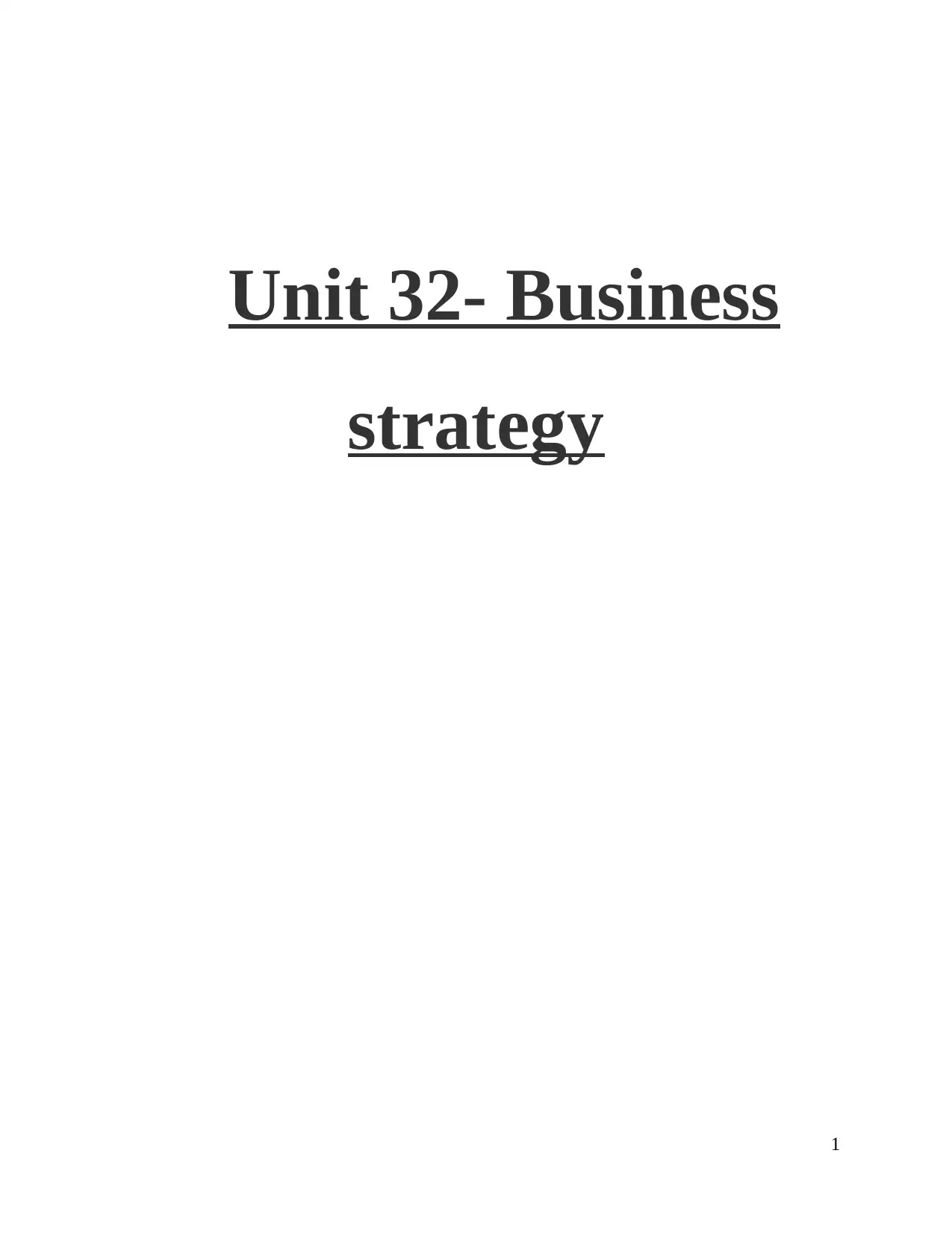
Unit 32- Business
strategy
1
strategy
1
Paraphrase This Document
Need a fresh take? Get an instant paraphrase of this document with our AI Paraphraser
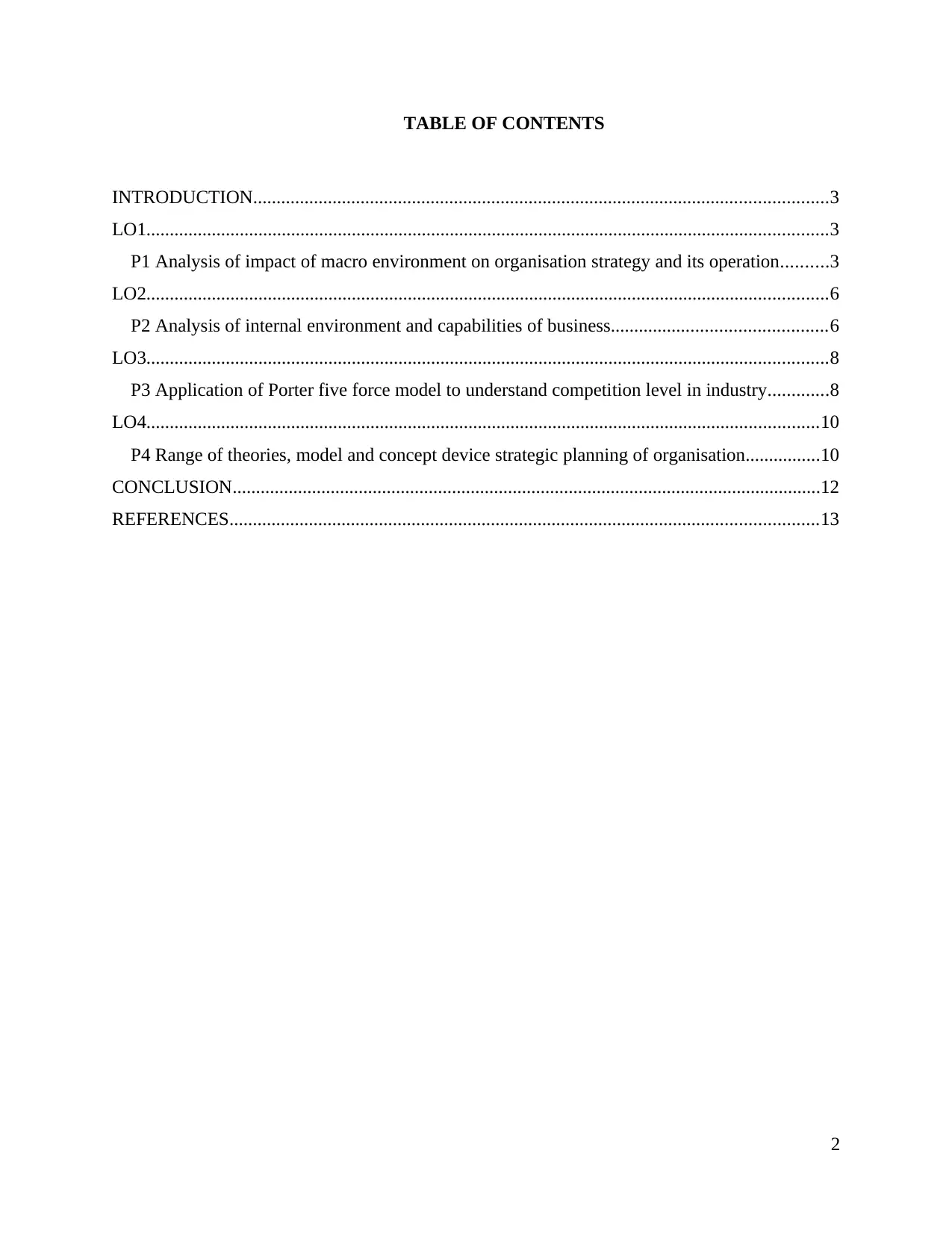
TABLE OF CONTENTS
INTRODUCTION...........................................................................................................................3
LO1..................................................................................................................................................3
P1 Analysis of impact of macro environment on organisation strategy and its operation..........3
LO2..................................................................................................................................................6
P2 Analysis of internal environment and capabilities of business..............................................6
LO3..................................................................................................................................................8
P3 Application of Porter five force model to understand competition level in industry.............8
LO4................................................................................................................................................10
P4 Range of theories, model and concept device strategic planning of organisation................10
CONCLUSION..............................................................................................................................12
REFERENCES..............................................................................................................................13
2
INTRODUCTION...........................................................................................................................3
LO1..................................................................................................................................................3
P1 Analysis of impact of macro environment on organisation strategy and its operation..........3
LO2..................................................................................................................................................6
P2 Analysis of internal environment and capabilities of business..............................................6
LO3..................................................................................................................................................8
P3 Application of Porter five force model to understand competition level in industry.............8
LO4................................................................................................................................................10
P4 Range of theories, model and concept device strategic planning of organisation................10
CONCLUSION..............................................................................................................................12
REFERENCES..............................................................................................................................13
2
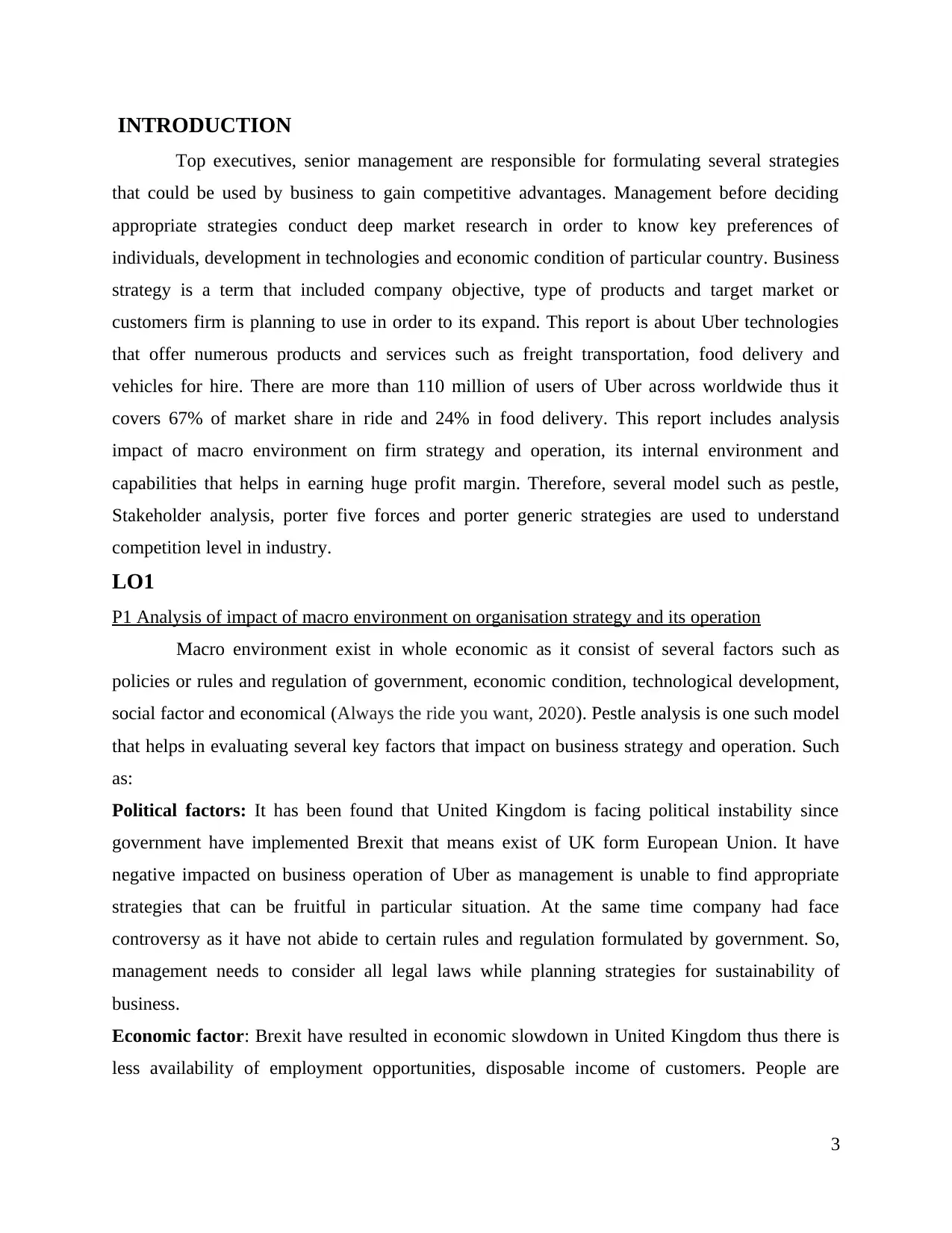
INTRODUCTION
Top executives, senior management are responsible for formulating several strategies
that could be used by business to gain competitive advantages. Management before deciding
appropriate strategies conduct deep market research in order to know key preferences of
individuals, development in technologies and economic condition of particular country. Business
strategy is a term that included company objective, type of products and target market or
customers firm is planning to use in order to its expand. This report is about Uber technologies
that offer numerous products and services such as freight transportation, food delivery and
vehicles for hire. There are more than 110 million of users of Uber across worldwide thus it
covers 67% of market share in ride and 24% in food delivery. This report includes analysis
impact of macro environment on firm strategy and operation, its internal environment and
capabilities that helps in earning huge profit margin. Therefore, several model such as pestle,
Stakeholder analysis, porter five forces and porter generic strategies are used to understand
competition level in industry.
LO1
P1 Analysis of impact of macro environment on organisation strategy and its operation
Macro environment exist in whole economic as it consist of several factors such as
policies or rules and regulation of government, economic condition, technological development,
social factor and economical (Always the ride you want, 2020). Pestle analysis is one such model
that helps in evaluating several key factors that impact on business strategy and operation. Such
as:
Political factors: It has been found that United Kingdom is facing political instability since
government have implemented Brexit that means exist of UK form European Union. It have
negative impacted on business operation of Uber as management is unable to find appropriate
strategies that can be fruitful in particular situation. At the same time company had face
controversy as it have not abide to certain rules and regulation formulated by government. So,
management needs to consider all legal laws while planning strategies for sustainability of
business.
Economic factor: Brexit have resulted in economic slowdown in United Kingdom thus there is
less availability of employment opportunities, disposable income of customers. People are
3
Top executives, senior management are responsible for formulating several strategies
that could be used by business to gain competitive advantages. Management before deciding
appropriate strategies conduct deep market research in order to know key preferences of
individuals, development in technologies and economic condition of particular country. Business
strategy is a term that included company objective, type of products and target market or
customers firm is planning to use in order to its expand. This report is about Uber technologies
that offer numerous products and services such as freight transportation, food delivery and
vehicles for hire. There are more than 110 million of users of Uber across worldwide thus it
covers 67% of market share in ride and 24% in food delivery. This report includes analysis
impact of macro environment on firm strategy and operation, its internal environment and
capabilities that helps in earning huge profit margin. Therefore, several model such as pestle,
Stakeholder analysis, porter five forces and porter generic strategies are used to understand
competition level in industry.
LO1
P1 Analysis of impact of macro environment on organisation strategy and its operation
Macro environment exist in whole economic as it consist of several factors such as
policies or rules and regulation of government, economic condition, technological development,
social factor and economical (Always the ride you want, 2020). Pestle analysis is one such model
that helps in evaluating several key factors that impact on business strategy and operation. Such
as:
Political factors: It has been found that United Kingdom is facing political instability since
government have implemented Brexit that means exist of UK form European Union. It have
negative impacted on business operation of Uber as management is unable to find appropriate
strategies that can be fruitful in particular situation. At the same time company had face
controversy as it have not abide to certain rules and regulation formulated by government. So,
management needs to consider all legal laws while planning strategies for sustainability of
business.
Economic factor: Brexit have resulted in economic slowdown in United Kingdom thus there is
less availability of employment opportunities, disposable income of customers. People are
3
⊘ This is a preview!⊘
Do you want full access?
Subscribe today to unlock all pages.

Trusted by 1+ million students worldwide
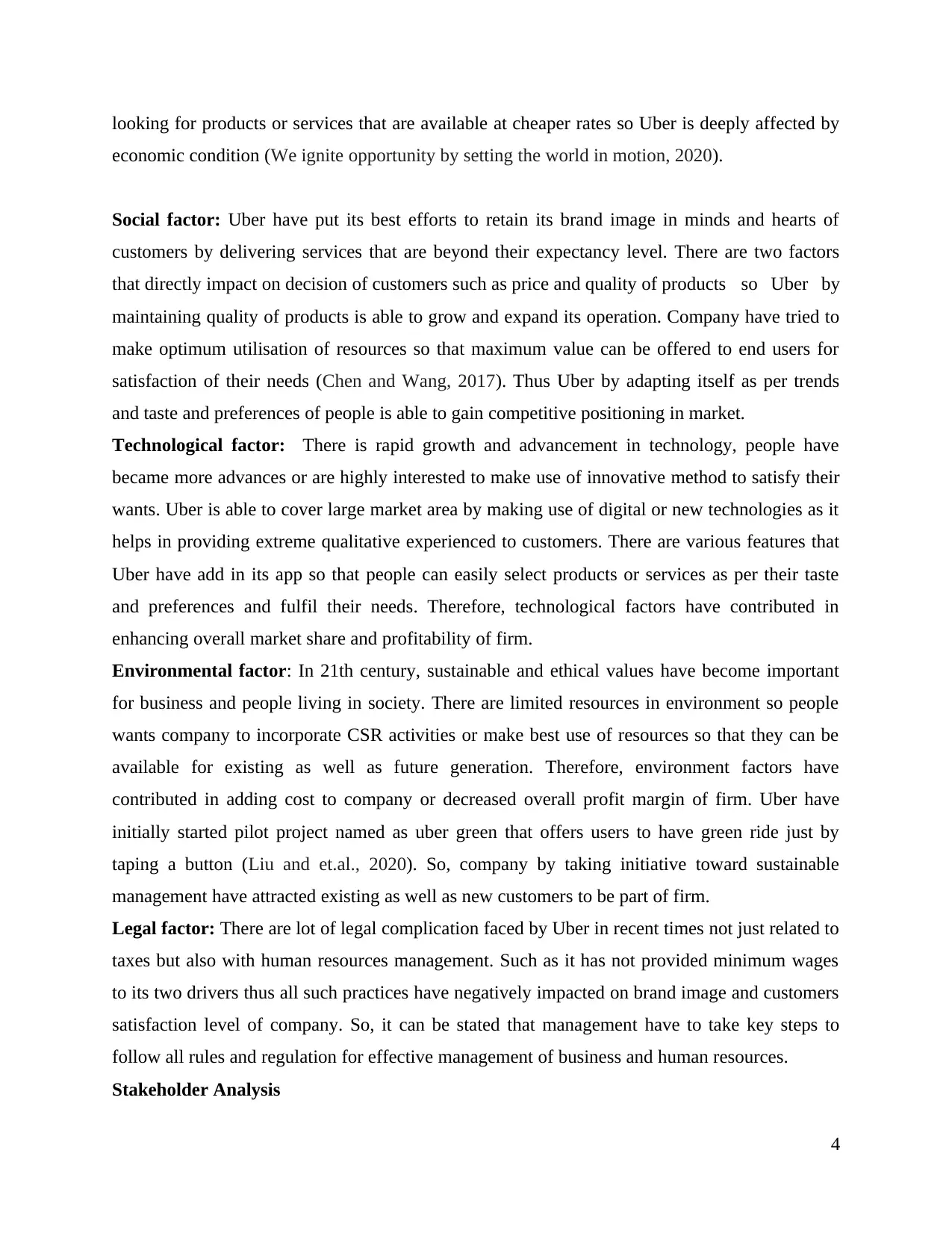
looking for products or services that are available at cheaper rates so Uber is deeply affected by
economic condition (We ignite opportunity by setting the world in motion, 2020).
Social factor: Uber have put its best efforts to retain its brand image in minds and hearts of
customers by delivering services that are beyond their expectancy level. There are two factors
that directly impact on decision of customers such as price and quality of products so Uber by
maintaining quality of products is able to grow and expand its operation. Company have tried to
make optimum utilisation of resources so that maximum value can be offered to end users for
satisfaction of their needs (Chen and Wang, 2017). Thus Uber by adapting itself as per trends
and taste and preferences of people is able to gain competitive positioning in market.
Technological factor: There is rapid growth and advancement in technology, people have
became more advances or are highly interested to make use of innovative method to satisfy their
wants. Uber is able to cover large market area by making use of digital or new technologies as it
helps in providing extreme qualitative experienced to customers. There are various features that
Uber have add in its app so that people can easily select products or services as per their taste
and preferences and fulfil their needs. Therefore, technological factors have contributed in
enhancing overall market share and profitability of firm.
Environmental factor: In 21th century, sustainable and ethical values have become important
for business and people living in society. There are limited resources in environment so people
wants company to incorporate CSR activities or make best use of resources so that they can be
available for existing as well as future generation. Therefore, environment factors have
contributed in adding cost to company or decreased overall profit margin of firm. Uber have
initially started pilot project named as uber green that offers users to have green ride just by
taping a button (Liu and et.al., 2020). So, company by taking initiative toward sustainable
management have attracted existing as well as new customers to be part of firm.
Legal factor: There are lot of legal complication faced by Uber in recent times not just related to
taxes but also with human resources management. Such as it has not provided minimum wages
to its two drivers thus all such practices have negatively impacted on brand image and customers
satisfaction level of company. So, it can be stated that management have to take key steps to
follow all rules and regulation for effective management of business and human resources.
Stakeholder Analysis
4
economic condition (We ignite opportunity by setting the world in motion, 2020).
Social factor: Uber have put its best efforts to retain its brand image in minds and hearts of
customers by delivering services that are beyond their expectancy level. There are two factors
that directly impact on decision of customers such as price and quality of products so Uber by
maintaining quality of products is able to grow and expand its operation. Company have tried to
make optimum utilisation of resources so that maximum value can be offered to end users for
satisfaction of their needs (Chen and Wang, 2017). Thus Uber by adapting itself as per trends
and taste and preferences of people is able to gain competitive positioning in market.
Technological factor: There is rapid growth and advancement in technology, people have
became more advances or are highly interested to make use of innovative method to satisfy their
wants. Uber is able to cover large market area by making use of digital or new technologies as it
helps in providing extreme qualitative experienced to customers. There are various features that
Uber have add in its app so that people can easily select products or services as per their taste
and preferences and fulfil their needs. Therefore, technological factors have contributed in
enhancing overall market share and profitability of firm.
Environmental factor: In 21th century, sustainable and ethical values have become important
for business and people living in society. There are limited resources in environment so people
wants company to incorporate CSR activities or make best use of resources so that they can be
available for existing as well as future generation. Therefore, environment factors have
contributed in adding cost to company or decreased overall profit margin of firm. Uber have
initially started pilot project named as uber green that offers users to have green ride just by
taping a button (Liu and et.al., 2020). So, company by taking initiative toward sustainable
management have attracted existing as well as new customers to be part of firm.
Legal factor: There are lot of legal complication faced by Uber in recent times not just related to
taxes but also with human resources management. Such as it has not provided minimum wages
to its two drivers thus all such practices have negatively impacted on brand image and customers
satisfaction level of company. So, it can be stated that management have to take key steps to
follow all rules and regulation for effective management of business and human resources.
Stakeholder Analysis
4
Paraphrase This Document
Need a fresh take? Get an instant paraphrase of this document with our AI Paraphraser

Stakeholders are key individuals that are interest in growth and operation of business as
they are directly or indirectly affected by it such as employees, customers, suppliers, government
and investors. Stakeholder’s analysis is model that is used to categorised people on the basis of
level of interest, participation and influences on project. Therefore, stakeholder analysis of Uber
is done in order to know parties that are interest or less interest in firm operation. Such as:
High influence and low stake: These are stakeholders that have direct influence on company
operation such as customers of Uber have high influenced but minimum stake or interest in
organisation (What Is Stakeholder Analysis and Mapping and How Do You Do It Effectively,
2019). So, management always handle customers with care so that they are motivate to retained
their satisfaction within organisation for longer time frame.
High influences and high stake: Directors, senior’s executives and investors of Ubers are
people that have both high power and more interest in growth and development of firm as they
have invested their capital. Therefore, they have given top priority in crucial or all decision
making of company.
Low influenced and low stake: Suppliers of Uber have low influences and stake in company as
there are number of firms that offers similar qualities of products and services at minimum price.
Low influence and high stake: These are stakeholders that have low influence on firm operation
but are highly interested in organisation growth (Braun, Latham and Cannatelli, 2019). Such as
employees of Uber have high interest in firm expansion so management have initiated them to
take active part in several functions of organisation.
Figure 1: Stakeholder Analysis
5
they are directly or indirectly affected by it such as employees, customers, suppliers, government
and investors. Stakeholder’s analysis is model that is used to categorised people on the basis of
level of interest, participation and influences on project. Therefore, stakeholder analysis of Uber
is done in order to know parties that are interest or less interest in firm operation. Such as:
High influence and low stake: These are stakeholders that have direct influence on company
operation such as customers of Uber have high influenced but minimum stake or interest in
organisation (What Is Stakeholder Analysis and Mapping and How Do You Do It Effectively,
2019). So, management always handle customers with care so that they are motivate to retained
their satisfaction within organisation for longer time frame.
High influences and high stake: Directors, senior’s executives and investors of Ubers are
people that have both high power and more interest in growth and development of firm as they
have invested their capital. Therefore, they have given top priority in crucial or all decision
making of company.
Low influenced and low stake: Suppliers of Uber have low influences and stake in company as
there are number of firms that offers similar qualities of products and services at minimum price.
Low influence and high stake: These are stakeholders that have low influence on firm operation
but are highly interested in organisation growth (Braun, Latham and Cannatelli, 2019). Such as
employees of Uber have high interest in firm expansion so management have initiated them to
take active part in several functions of organisation.
Figure 1: Stakeholder Analysis
5
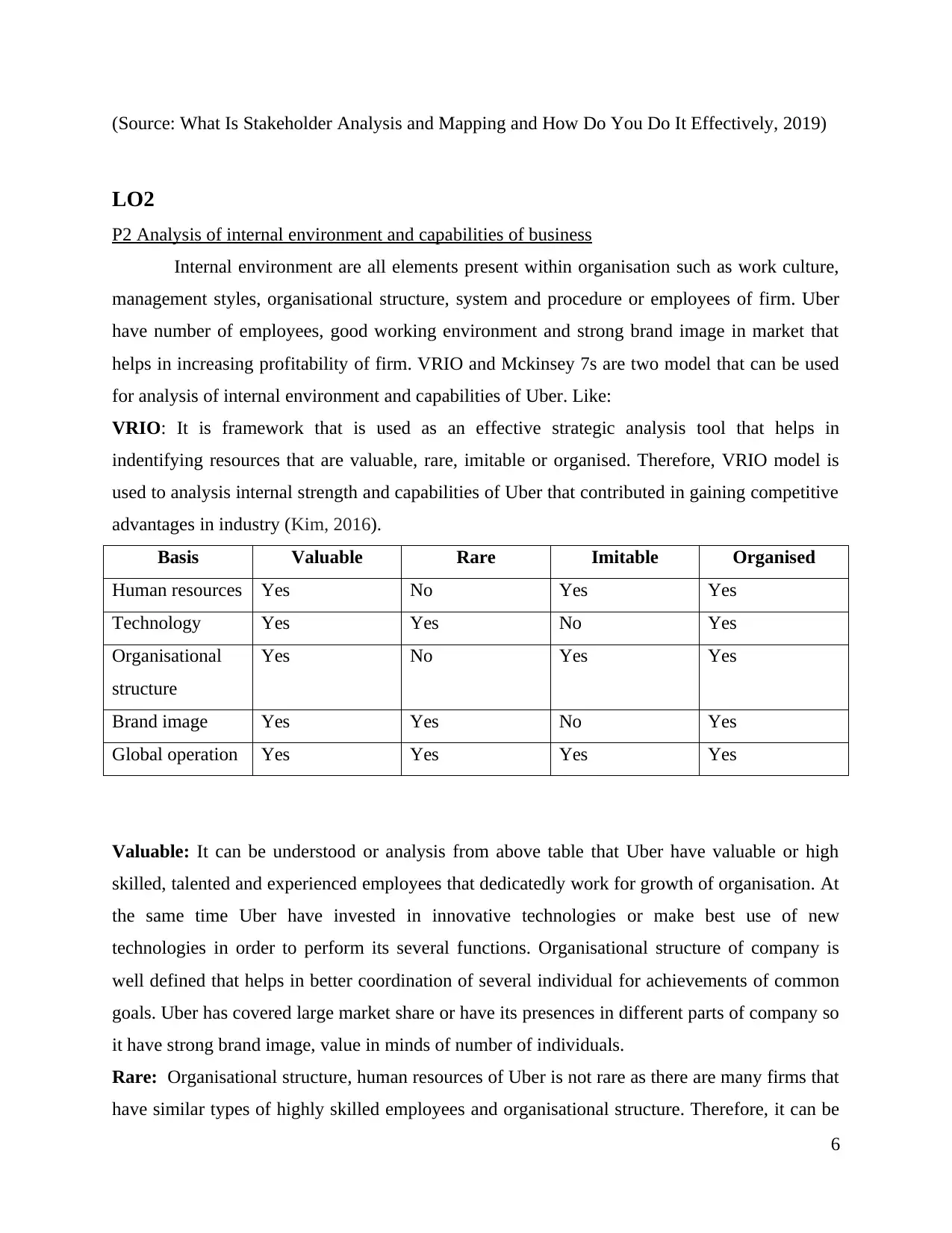
(Source: What Is Stakeholder Analysis and Mapping and How Do You Do It Effectively, 2019)
LO2
P2 Analysis of internal environment and capabilities of business
Internal environment are all elements present within organisation such as work culture,
management styles, organisational structure, system and procedure or employees of firm. Uber
have number of employees, good working environment and strong brand image in market that
helps in increasing profitability of firm. VRIO and Mckinsey 7s are two model that can be used
for analysis of internal environment and capabilities of Uber. Like:
VRIO: It is framework that is used as an effective strategic analysis tool that helps in
indentifying resources that are valuable, rare, imitable or organised. Therefore, VRIO model is
used to analysis internal strength and capabilities of Uber that contributed in gaining competitive
advantages in industry (Kim, 2016).
Basis Valuable Rare Imitable Organised
Human resources Yes No Yes Yes
Technology Yes Yes No Yes
Organisational
structure
Yes No Yes Yes
Brand image Yes Yes No Yes
Global operation Yes Yes Yes Yes
Valuable: It can be understood or analysis from above table that Uber have valuable or high
skilled, talented and experienced employees that dedicatedly work for growth of organisation. At
the same time Uber have invested in innovative technologies or make best use of new
technologies in order to perform its several functions. Organisational structure of company is
well defined that helps in better coordination of several individual for achievements of common
goals. Uber has covered large market share or have its presences in different parts of company so
it have strong brand image, value in minds of number of individuals.
Rare: Organisational structure, human resources of Uber is not rare as there are many firms that
have similar types of highly skilled employees and organisational structure. Therefore, it can be
6
LO2
P2 Analysis of internal environment and capabilities of business
Internal environment are all elements present within organisation such as work culture,
management styles, organisational structure, system and procedure or employees of firm. Uber
have number of employees, good working environment and strong brand image in market that
helps in increasing profitability of firm. VRIO and Mckinsey 7s are two model that can be used
for analysis of internal environment and capabilities of Uber. Like:
VRIO: It is framework that is used as an effective strategic analysis tool that helps in
indentifying resources that are valuable, rare, imitable or organised. Therefore, VRIO model is
used to analysis internal strength and capabilities of Uber that contributed in gaining competitive
advantages in industry (Kim, 2016).
Basis Valuable Rare Imitable Organised
Human resources Yes No Yes Yes
Technology Yes Yes No Yes
Organisational
structure
Yes No Yes Yes
Brand image Yes Yes No Yes
Global operation Yes Yes Yes Yes
Valuable: It can be understood or analysis from above table that Uber have valuable or high
skilled, talented and experienced employees that dedicatedly work for growth of organisation. At
the same time Uber have invested in innovative technologies or make best use of new
technologies in order to perform its several functions. Organisational structure of company is
well defined that helps in better coordination of several individual for achievements of common
goals. Uber has covered large market share or have its presences in different parts of company so
it have strong brand image, value in minds of number of individuals.
Rare: Organisational structure, human resources of Uber is not rare as there are many firms that
have similar types of highly skilled employees and organisational structure. Therefore, it can be
6
⊘ This is a preview!⊘
Do you want full access?
Subscribe today to unlock all pages.

Trusted by 1+ million students worldwide

stated that Uber have rare technology; differentiate goodwill and brand image or competitive
positioning in market (SLÁVIK and ZAGORŠEK, 2017).
Imitable: Competitors of Uber can easily imitate human resources or higher similar kinds of
individual that have same knowledge, experienced and they can also have global operation as
Uber. Whereas brand image and technology of Uber cannot be imitated or copied by others to
attract customers as it have make use of patent and trademarks.
Mckinsey 7s Framework: It is also used to analysis internal capabilities of firm that have
categorised seven key elements into two that is either “hard” or “soft”. Strategy, structure and
systems are hard elements whereas shared value, skills, staff, styles and skills are soft elements
(Pourali and et.al., 2019).
Strategy: Uber management have devoted its time and efforts to formulate effective strategies or
find innovative ideas that can be used to meet customer’s expectancy. Such as it have formulated
strategy to provide facilities to people to hire vehicles for food delivery, freight transportation
etc. Thus, its unique idea or innovative business has contributed in attracting maximum number
of individuals.
Structure: Company has definite organisation structure that helps manager in deciding
appropriate task, roles and responsibilities need to be performed by specific individuals. Division
organisational structure of Uber has contributed in better coordination of functions or operation
that it have in different parts of country (Bentley-Goode, Omer and Twedt, 2019).
System: Manager of Uber have formulate clear and strict rules, regulation, standard or
procedure that need to be abide by each employees while performing their respective task.
Standard system have helped in optimum utilisation of resources, better delivery of services to
end customers thus enhance brand image of firm.
Shared value: Uber have provided friendly working environment or social culture to people so
that individual form different background can easily coordinate with each others. Thus, they can
work together as team for achievements of common objectives of firm.
Skills: Most of the employees of company have several skills and capabilities that help them in
completing task in best possible manners or without errors and mistakes.
Staff: Company has talented, knowledgeable employees that are motivated to work hard for
Uber so that it can expand its market share in limited time frame and cost (Tasgit, Şentürk, and
Ergün, 2017).
7
positioning in market (SLÁVIK and ZAGORŠEK, 2017).
Imitable: Competitors of Uber can easily imitate human resources or higher similar kinds of
individual that have same knowledge, experienced and they can also have global operation as
Uber. Whereas brand image and technology of Uber cannot be imitated or copied by others to
attract customers as it have make use of patent and trademarks.
Mckinsey 7s Framework: It is also used to analysis internal capabilities of firm that have
categorised seven key elements into two that is either “hard” or “soft”. Strategy, structure and
systems are hard elements whereas shared value, skills, staff, styles and skills are soft elements
(Pourali and et.al., 2019).
Strategy: Uber management have devoted its time and efforts to formulate effective strategies or
find innovative ideas that can be used to meet customer’s expectancy. Such as it have formulated
strategy to provide facilities to people to hire vehicles for food delivery, freight transportation
etc. Thus, its unique idea or innovative business has contributed in attracting maximum number
of individuals.
Structure: Company has definite organisation structure that helps manager in deciding
appropriate task, roles and responsibilities need to be performed by specific individuals. Division
organisational structure of Uber has contributed in better coordination of functions or operation
that it have in different parts of country (Bentley-Goode, Omer and Twedt, 2019).
System: Manager of Uber have formulate clear and strict rules, regulation, standard or
procedure that need to be abide by each employees while performing their respective task.
Standard system have helped in optimum utilisation of resources, better delivery of services to
end customers thus enhance brand image of firm.
Shared value: Uber have provided friendly working environment or social culture to people so
that individual form different background can easily coordinate with each others. Thus, they can
work together as team for achievements of common objectives of firm.
Skills: Most of the employees of company have several skills and capabilities that help them in
completing task in best possible manners or without errors and mistakes.
Staff: Company has talented, knowledgeable employees that are motivated to work hard for
Uber so that it can expand its market share in limited time frame and cost (Tasgit, Şentürk, and
Ergün, 2017).
7
Paraphrase This Document
Need a fresh take? Get an instant paraphrase of this document with our AI Paraphraser
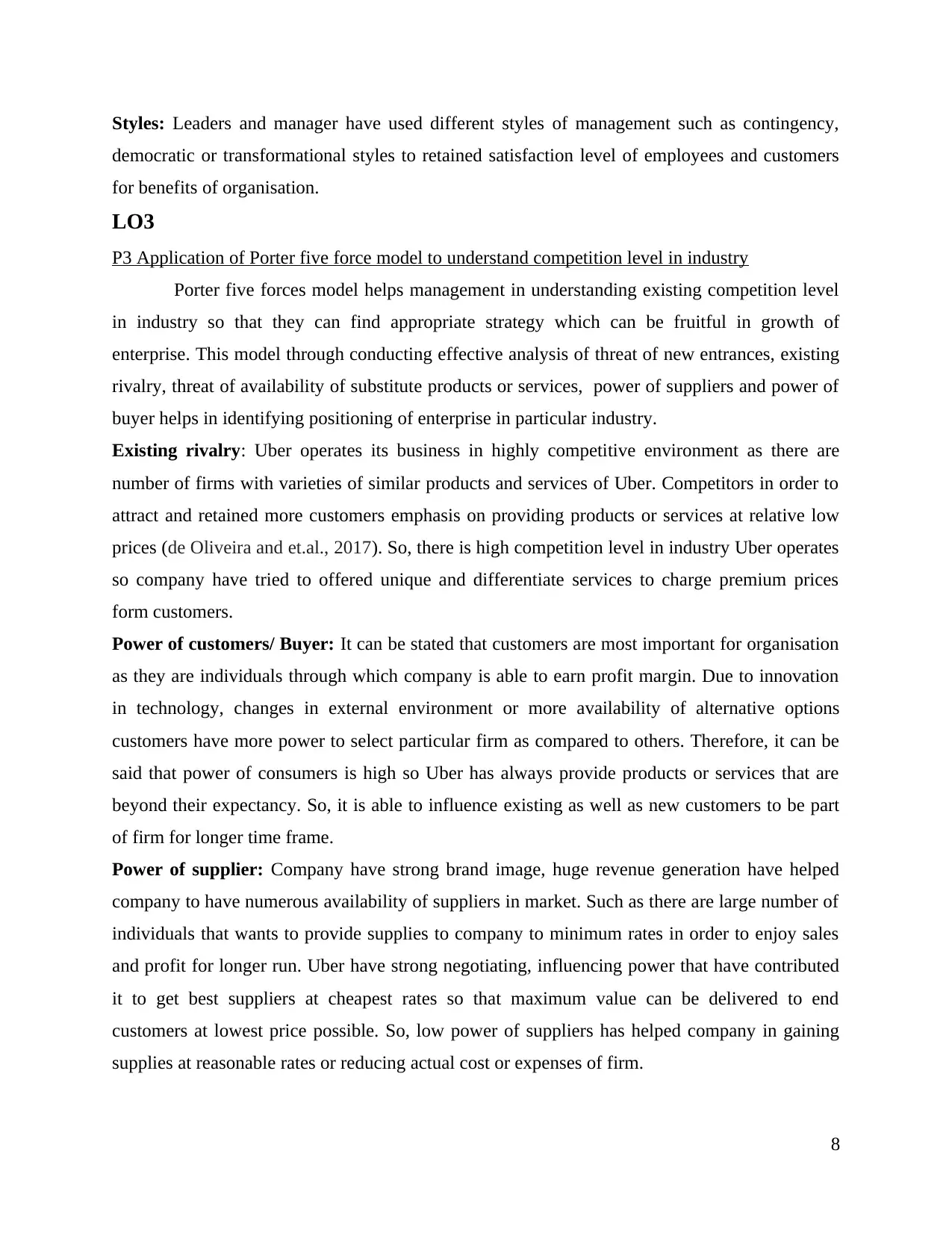
Styles: Leaders and manager have used different styles of management such as contingency,
democratic or transformational styles to retained satisfaction level of employees and customers
for benefits of organisation.
LO3
P3 Application of Porter five force model to understand competition level in industry
Porter five forces model helps management in understanding existing competition level
in industry so that they can find appropriate strategy which can be fruitful in growth of
enterprise. This model through conducting effective analysis of threat of new entrances, existing
rivalry, threat of availability of substitute products or services, power of suppliers and power of
buyer helps in identifying positioning of enterprise in particular industry.
Existing rivalry: Uber operates its business in highly competitive environment as there are
number of firms with varieties of similar products and services of Uber. Competitors in order to
attract and retained more customers emphasis on providing products or services at relative low
prices (de Oliveira and et.al., 2017). So, there is high competition level in industry Uber operates
so company have tried to offered unique and differentiate services to charge premium prices
form customers.
Power of customers/ Buyer: It can be stated that customers are most important for organisation
as they are individuals through which company is able to earn profit margin. Due to innovation
in technology, changes in external environment or more availability of alternative options
customers have more power to select particular firm as compared to others. Therefore, it can be
said that power of consumers is high so Uber has always provide products or services that are
beyond their expectancy. So, it is able to influence existing as well as new customers to be part
of firm for longer time frame.
Power of supplier: Company have strong brand image, huge revenue generation have helped
company to have numerous availability of suppliers in market. Such as there are large number of
individuals that wants to provide supplies to company to minimum rates in order to enjoy sales
and profit for longer run. Uber have strong negotiating, influencing power that have contributed
it to get best suppliers at cheapest rates so that maximum value can be delivered to end
customers at lowest price possible. So, low power of suppliers has helped company in gaining
supplies at reasonable rates or reducing actual cost or expenses of firm.
8
democratic or transformational styles to retained satisfaction level of employees and customers
for benefits of organisation.
LO3
P3 Application of Porter five force model to understand competition level in industry
Porter five forces model helps management in understanding existing competition level
in industry so that they can find appropriate strategy which can be fruitful in growth of
enterprise. This model through conducting effective analysis of threat of new entrances, existing
rivalry, threat of availability of substitute products or services, power of suppliers and power of
buyer helps in identifying positioning of enterprise in particular industry.
Existing rivalry: Uber operates its business in highly competitive environment as there are
number of firms with varieties of similar products and services of Uber. Competitors in order to
attract and retained more customers emphasis on providing products or services at relative low
prices (de Oliveira and et.al., 2017). So, there is high competition level in industry Uber operates
so company have tried to offered unique and differentiate services to charge premium prices
form customers.
Power of customers/ Buyer: It can be stated that customers are most important for organisation
as they are individuals through which company is able to earn profit margin. Due to innovation
in technology, changes in external environment or more availability of alternative options
customers have more power to select particular firm as compared to others. Therefore, it can be
said that power of consumers is high so Uber has always provide products or services that are
beyond their expectancy. So, it is able to influence existing as well as new customers to be part
of firm for longer time frame.
Power of supplier: Company have strong brand image, huge revenue generation have helped
company to have numerous availability of suppliers in market. Such as there are large number of
individuals that wants to provide supplies to company to minimum rates in order to enjoy sales
and profit for longer run. Uber have strong negotiating, influencing power that have contributed
it to get best suppliers at cheapest rates so that maximum value can be delivered to end
customers at lowest price possible. So, low power of suppliers has helped company in gaining
supplies at reasonable rates or reducing actual cost or expenses of firm.
8
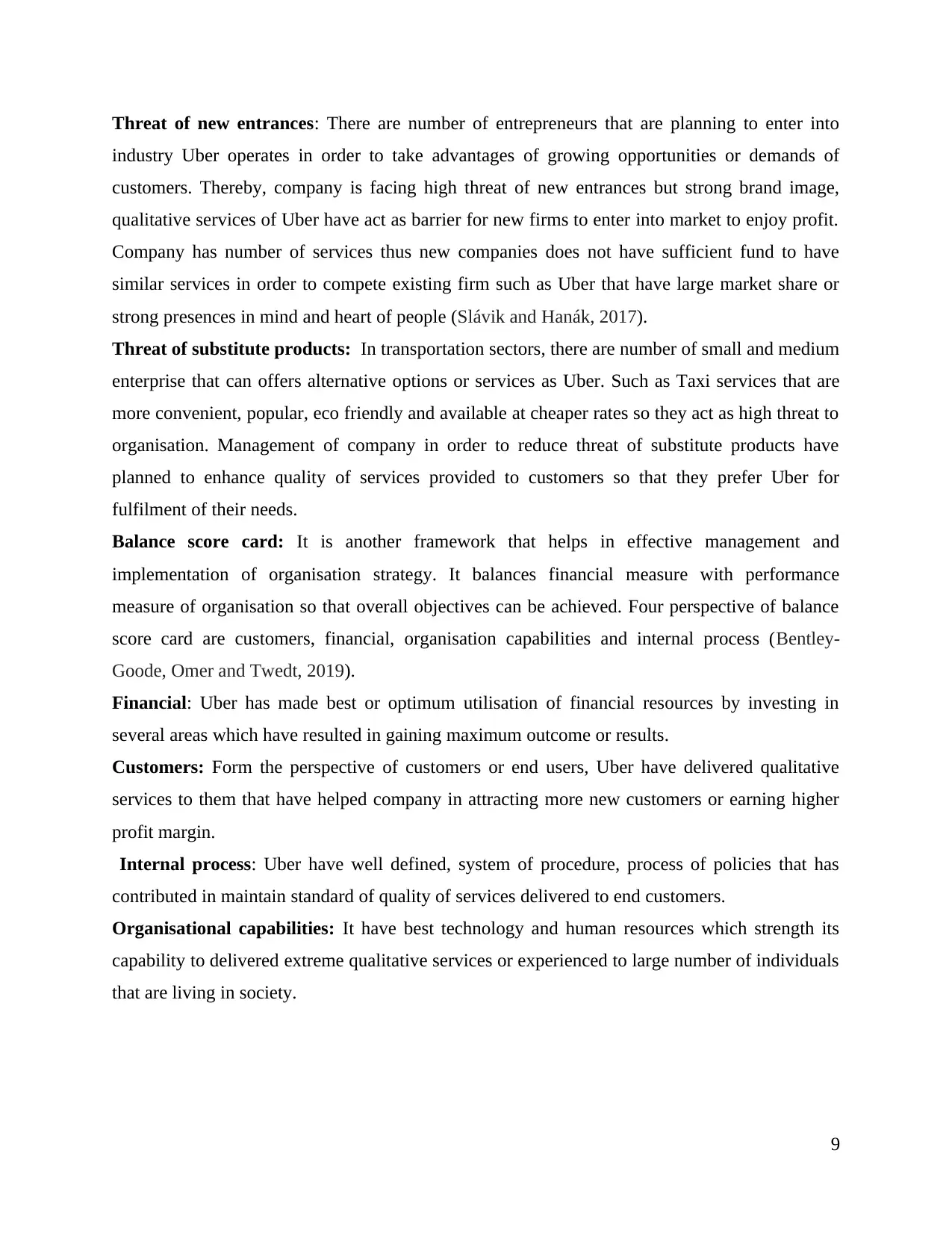
Threat of new entrances: There are number of entrepreneurs that are planning to enter into
industry Uber operates in order to take advantages of growing opportunities or demands of
customers. Thereby, company is facing high threat of new entrances but strong brand image,
qualitative services of Uber have act as barrier for new firms to enter into market to enjoy profit.
Company has number of services thus new companies does not have sufficient fund to have
similar services in order to compete existing firm such as Uber that have large market share or
strong presences in mind and heart of people (Slávik and Hanák, 2017).
Threat of substitute products: In transportation sectors, there are number of small and medium
enterprise that can offers alternative options or services as Uber. Such as Taxi services that are
more convenient, popular, eco friendly and available at cheaper rates so they act as high threat to
organisation. Management of company in order to reduce threat of substitute products have
planned to enhance quality of services provided to customers so that they prefer Uber for
fulfilment of their needs.
Balance score card: It is another framework that helps in effective management and
implementation of organisation strategy. It balances financial measure with performance
measure of organisation so that overall objectives can be achieved. Four perspective of balance
score card are customers, financial, organisation capabilities and internal process (Bentley-
Goode, Omer and Twedt, 2019).
Financial: Uber has made best or optimum utilisation of financial resources by investing in
several areas which have resulted in gaining maximum outcome or results.
Customers: Form the perspective of customers or end users, Uber have delivered qualitative
services to them that have helped company in attracting more new customers or earning higher
profit margin.
Internal process: Uber have well defined, system of procedure, process of policies that has
contributed in maintain standard of quality of services delivered to end customers.
Organisational capabilities: It have best technology and human resources which strength its
capability to delivered extreme qualitative services or experienced to large number of individuals
that are living in society.
9
industry Uber operates in order to take advantages of growing opportunities or demands of
customers. Thereby, company is facing high threat of new entrances but strong brand image,
qualitative services of Uber have act as barrier for new firms to enter into market to enjoy profit.
Company has number of services thus new companies does not have sufficient fund to have
similar services in order to compete existing firm such as Uber that have large market share or
strong presences in mind and heart of people (Slávik and Hanák, 2017).
Threat of substitute products: In transportation sectors, there are number of small and medium
enterprise that can offers alternative options or services as Uber. Such as Taxi services that are
more convenient, popular, eco friendly and available at cheaper rates so they act as high threat to
organisation. Management of company in order to reduce threat of substitute products have
planned to enhance quality of services provided to customers so that they prefer Uber for
fulfilment of their needs.
Balance score card: It is another framework that helps in effective management and
implementation of organisation strategy. It balances financial measure with performance
measure of organisation so that overall objectives can be achieved. Four perspective of balance
score card are customers, financial, organisation capabilities and internal process (Bentley-
Goode, Omer and Twedt, 2019).
Financial: Uber has made best or optimum utilisation of financial resources by investing in
several areas which have resulted in gaining maximum outcome or results.
Customers: Form the perspective of customers or end users, Uber have delivered qualitative
services to them that have helped company in attracting more new customers or earning higher
profit margin.
Internal process: Uber have well defined, system of procedure, process of policies that has
contributed in maintain standard of quality of services delivered to end customers.
Organisational capabilities: It have best technology and human resources which strength its
capability to delivered extreme qualitative services or experienced to large number of individuals
that are living in society.
9
⊘ This is a preview!⊘
Do you want full access?
Subscribe today to unlock all pages.

Trusted by 1+ million students worldwide
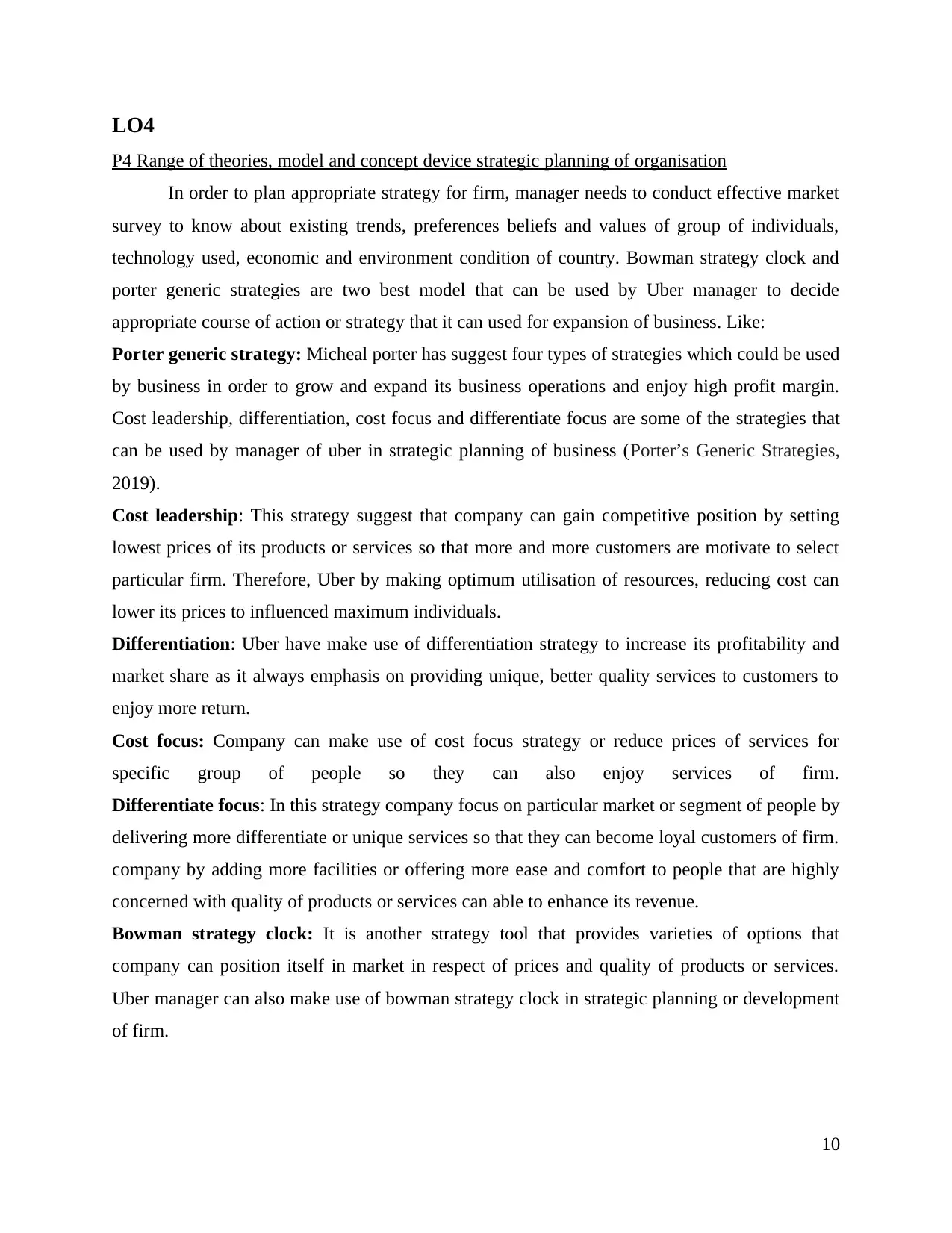
LO4
P4 Range of theories, model and concept device strategic planning of organisation
In order to plan appropriate strategy for firm, manager needs to conduct effective market
survey to know about existing trends, preferences beliefs and values of group of individuals,
technology used, economic and environment condition of country. Bowman strategy clock and
porter generic strategies are two best model that can be used by Uber manager to decide
appropriate course of action or strategy that it can used for expansion of business. Like:
Porter generic strategy: Micheal porter has suggest four types of strategies which could be used
by business in order to grow and expand its business operations and enjoy high profit margin.
Cost leadership, differentiation, cost focus and differentiate focus are some of the strategies that
can be used by manager of uber in strategic planning of business (Porter’s Generic Strategies,
2019).
Cost leadership: This strategy suggest that company can gain competitive position by setting
lowest prices of its products or services so that more and more customers are motivate to select
particular firm. Therefore, Uber by making optimum utilisation of resources, reducing cost can
lower its prices to influenced maximum individuals.
Differentiation: Uber have make use of differentiation strategy to increase its profitability and
market share as it always emphasis on providing unique, better quality services to customers to
enjoy more return.
Cost focus: Company can make use of cost focus strategy or reduce prices of services for
specific group of people so they can also enjoy services of firm.
Differentiate focus: In this strategy company focus on particular market or segment of people by
delivering more differentiate or unique services so that they can become loyal customers of firm.
company by adding more facilities or offering more ease and comfort to people that are highly
concerned with quality of products or services can able to enhance its revenue.
Bowman strategy clock: It is another strategy tool that provides varieties of options that
company can position itself in market in respect of prices and quality of products or services.
Uber manager can also make use of bowman strategy clock in strategic planning or development
of firm.
10
P4 Range of theories, model and concept device strategic planning of organisation
In order to plan appropriate strategy for firm, manager needs to conduct effective market
survey to know about existing trends, preferences beliefs and values of group of individuals,
technology used, economic and environment condition of country. Bowman strategy clock and
porter generic strategies are two best model that can be used by Uber manager to decide
appropriate course of action or strategy that it can used for expansion of business. Like:
Porter generic strategy: Micheal porter has suggest four types of strategies which could be used
by business in order to grow and expand its business operations and enjoy high profit margin.
Cost leadership, differentiation, cost focus and differentiate focus are some of the strategies that
can be used by manager of uber in strategic planning of business (Porter’s Generic Strategies,
2019).
Cost leadership: This strategy suggest that company can gain competitive position by setting
lowest prices of its products or services so that more and more customers are motivate to select
particular firm. Therefore, Uber by making optimum utilisation of resources, reducing cost can
lower its prices to influenced maximum individuals.
Differentiation: Uber have make use of differentiation strategy to increase its profitability and
market share as it always emphasis on providing unique, better quality services to customers to
enjoy more return.
Cost focus: Company can make use of cost focus strategy or reduce prices of services for
specific group of people so they can also enjoy services of firm.
Differentiate focus: In this strategy company focus on particular market or segment of people by
delivering more differentiate or unique services so that they can become loyal customers of firm.
company by adding more facilities or offering more ease and comfort to people that are highly
concerned with quality of products or services can able to enhance its revenue.
Bowman strategy clock: It is another strategy tool that provides varieties of options that
company can position itself in market in respect of prices and quality of products or services.
Uber manager can also make use of bowman strategy clock in strategic planning or development
of firm.
10
Paraphrase This Document
Need a fresh take? Get an instant paraphrase of this document with our AI Paraphraser
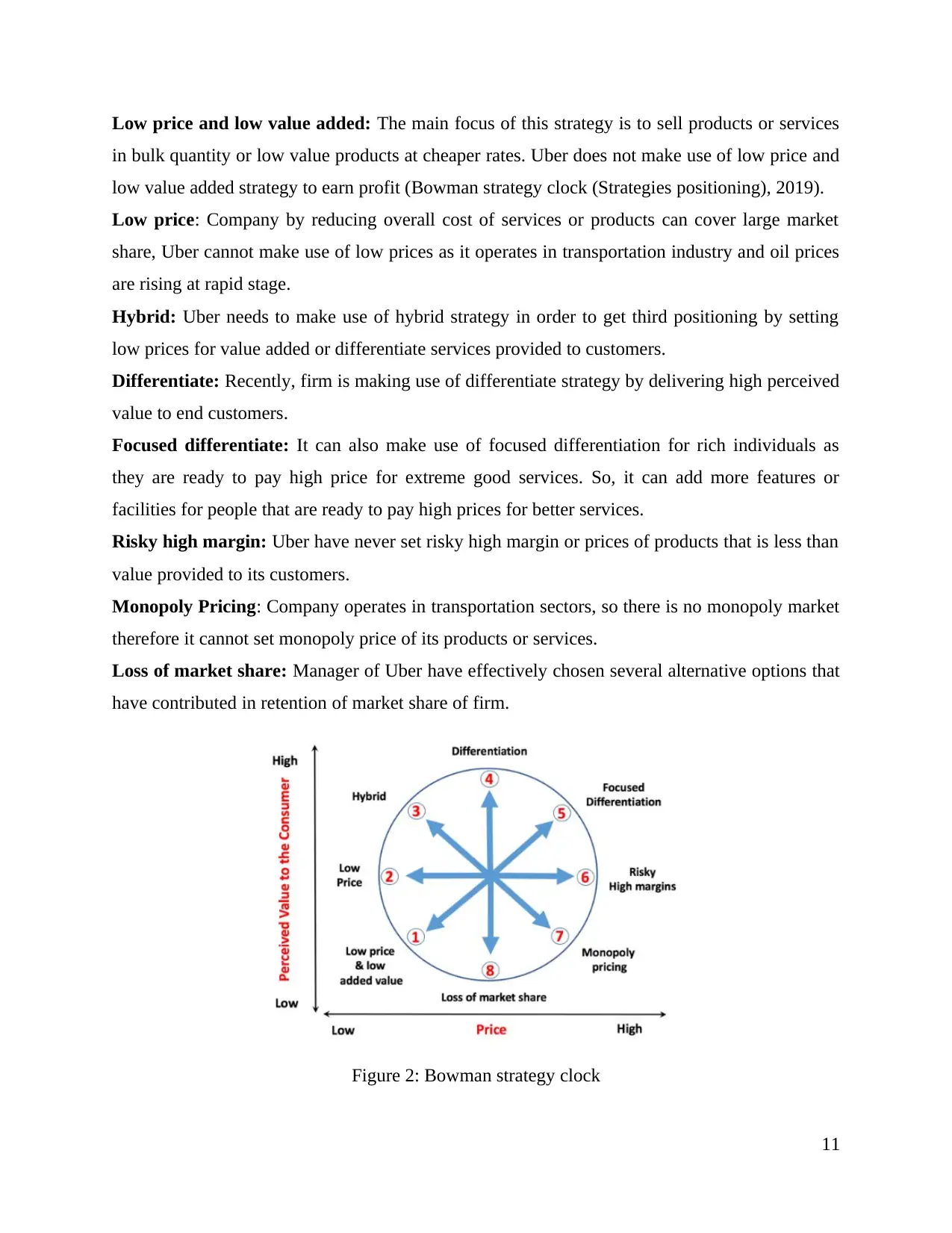
Low price and low value added: The main focus of this strategy is to sell products or services
in bulk quantity or low value products at cheaper rates. Uber does not make use of low price and
low value added strategy to earn profit (Bowman strategy clock (Strategies positioning), 2019).
Low price: Company by reducing overall cost of services or products can cover large market
share, Uber cannot make use of low prices as it operates in transportation industry and oil prices
are rising at rapid stage.
Hybrid: Uber needs to make use of hybrid strategy in order to get third positioning by setting
low prices for value added or differentiate services provided to customers.
Differentiate: Recently, firm is making use of differentiate strategy by delivering high perceived
value to end customers.
Focused differentiate: It can also make use of focused differentiation for rich individuals as
they are ready to pay high price for extreme good services. So, it can add more features or
facilities for people that are ready to pay high prices for better services.
Risky high margin: Uber have never set risky high margin or prices of products that is less than
value provided to its customers.
Monopoly Pricing: Company operates in transportation sectors, so there is no monopoly market
therefore it cannot set monopoly price of its products or services.
Loss of market share: Manager of Uber have effectively chosen several alternative options that
have contributed in retention of market share of firm.
Figure 2: Bowman strategy clock
11
in bulk quantity or low value products at cheaper rates. Uber does not make use of low price and
low value added strategy to earn profit (Bowman strategy clock (Strategies positioning), 2019).
Low price: Company by reducing overall cost of services or products can cover large market
share, Uber cannot make use of low prices as it operates in transportation industry and oil prices
are rising at rapid stage.
Hybrid: Uber needs to make use of hybrid strategy in order to get third positioning by setting
low prices for value added or differentiate services provided to customers.
Differentiate: Recently, firm is making use of differentiate strategy by delivering high perceived
value to end customers.
Focused differentiate: It can also make use of focused differentiation for rich individuals as
they are ready to pay high price for extreme good services. So, it can add more features or
facilities for people that are ready to pay high prices for better services.
Risky high margin: Uber have never set risky high margin or prices of products that is less than
value provided to its customers.
Monopoly Pricing: Company operates in transportation sectors, so there is no monopoly market
therefore it cannot set monopoly price of its products or services.
Loss of market share: Manager of Uber have effectively chosen several alternative options that
have contributed in retention of market share of firm.
Figure 2: Bowman strategy clock
11
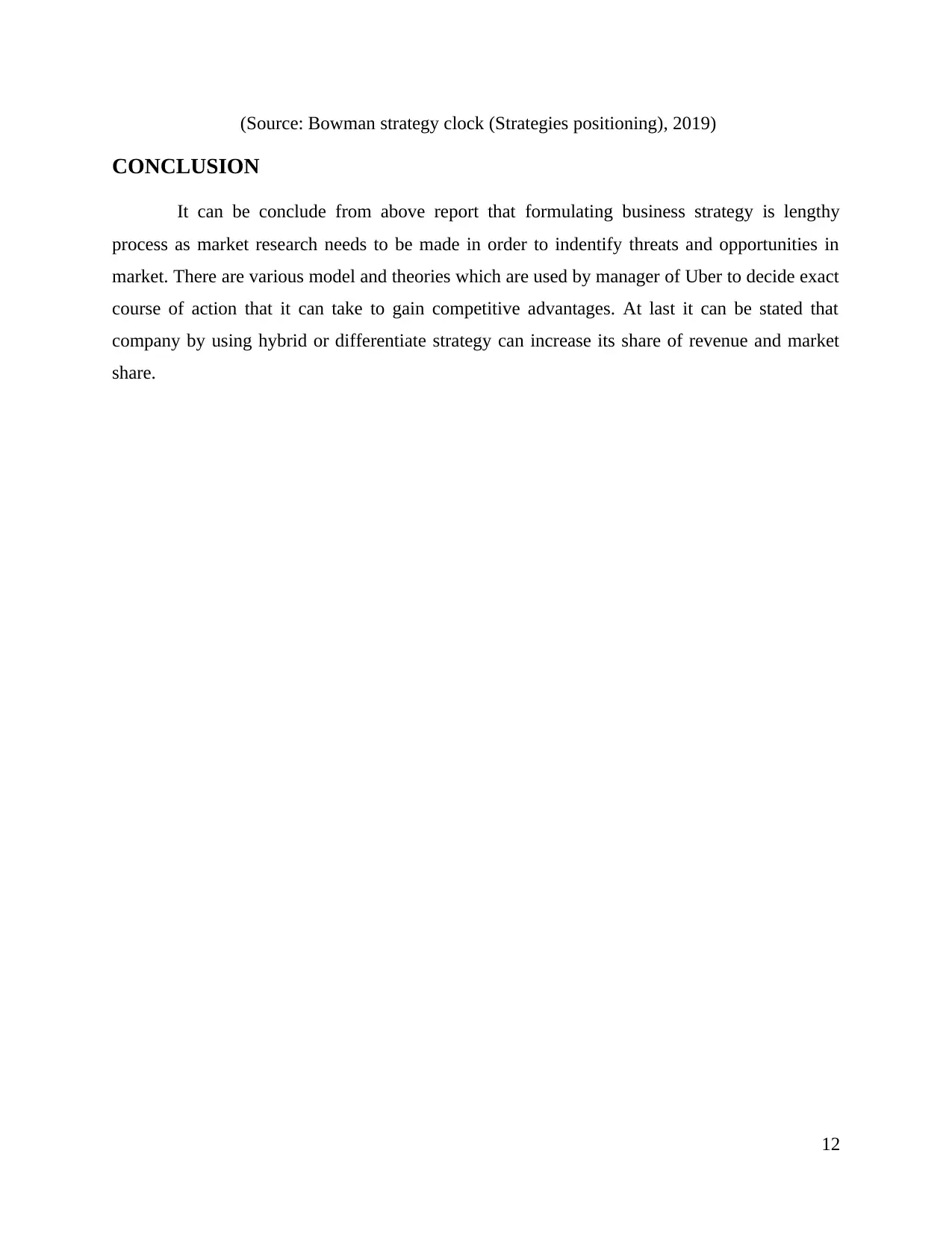
(Source: Bowman strategy clock (Strategies positioning), 2019)
CONCLUSION
It can be conclude from above report that formulating business strategy is lengthy
process as market research needs to be made in order to indentify threats and opportunities in
market. There are various model and theories which are used by manager of Uber to decide exact
course of action that it can take to gain competitive advantages. At last it can be stated that
company by using hybrid or differentiate strategy can increase its share of revenue and market
share.
12
CONCLUSION
It can be conclude from above report that formulating business strategy is lengthy
process as market research needs to be made in order to indentify threats and opportunities in
market. There are various model and theories which are used by manager of Uber to decide exact
course of action that it can take to gain competitive advantages. At last it can be stated that
company by using hybrid or differentiate strategy can increase its share of revenue and market
share.
12
⊘ This is a preview!⊘
Do you want full access?
Subscribe today to unlock all pages.

Trusted by 1+ million students worldwide
1 out of 17
Related Documents
Your All-in-One AI-Powered Toolkit for Academic Success.
+13062052269
info@desklib.com
Available 24*7 on WhatsApp / Email
![[object Object]](/_next/static/media/star-bottom.7253800d.svg)
Unlock your academic potential
Copyright © 2020–2025 A2Z Services. All Rights Reserved. Developed and managed by ZUCOL.





